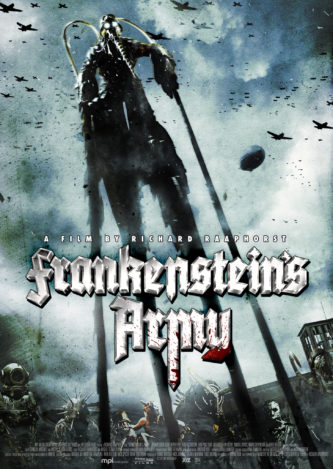 Oh, good: another found footage horror movie! This one at least has a somewhat unique set-up that doesn’t involve airheads running through forests. Rather, the setting here is WWII-era Germany, where a mad doctor is performing horrific experiments whose aftermath is captured by a Soviet cameraman. Some diverting nastiness ensues.
Oh, good: another found footage horror movie! This one at least has a somewhat unique set-up that doesn’t involve airheads running through forests. Rather, the setting here is WWII-era Germany, where a mad doctor is performing horrific experiments whose aftermath is captured by a Soviet cameraman. Some diverting nastiness ensues.
This low budgeter, an English language Czech-Danish co-production, garnered surprisingly positive reviews from publications like Variety and The Village Voice. It was released theatrically and on DVD in 2013 by Dark Sky Films, with the irresistible tagline “War is hell. This place is worse.”
WWII: a Russian platoon whose soldiers insist on filming their every move becomes lost behind enemy lines. After happening upon a skeleton with a weirdly shaped head the soldiers enter a village whose populace appears to be comprised entirely of drunken lunatics. This leads them to another village, this one in even worse shape: there are no people to be found, and the place is dominated by a church that has been turned into a factory.
In this forbidding environ a freaky stitched-up personage turns up and mutilates the platoon leader. His charges kill the creature and advance further into the village, where they happen upon a building containing a number of caged animals and an old man charged with feeding the critters. The old man speaks of a doctor who’s doing work in the area, leading the soldiers on a trek through a network of tunnels underneath the building. There they run into a number of bizarre mechanical monsters, and also several Nazis in hiding.
Around this point it’s revealed that one of the Russian soldiers has been tasked with capturing the (thus far unseen) doctor who created the monsters, apparently by stitching together the corpses of his fallen comrades. This sets off a search for the doctor that turns up loads of severed body parts, a traumatized young boy and more monsters. The boy and the monsters are killed, and the platoon’s cameraman thrown into a vat of body parts. This allows him access to parts of the building his comrades miss, most notably the mad doctor’s lair.
From there I’ll reveal no more of what happens, but will confess that there’s a definite reason the film is entitled FRANKENSTEIN’S ARMY.
You likely know what to expect from this film cinematically: in true found footage movie fashion the camera never stays still and the angles are consistently awkward. This helps in rendering the low budget creature effects convincing (as we never get a good enough look at the things to properly assess their construction) and also props up the underwritten script (whose shortcomings are excused, in theory at least, by the faux-documentary overlay), but makes for a consistently annoying viewing experience.
The film’s real shortcomings are conceptual. We’re asked to believe that somehow its protagonists were able to get ahold of a video camera in 1940s-era Russia, and one that records synchronized sound; some scratched-celluloid effects suggest that the filmmakers were trying to make it seem as if the pic was shot on actual film, but the ruse is never very convincing. Equally anachronistic is the fact that the allegedly Russian and German cast members all speak English.
None of the protagonists make much of an impression (the reason I didn’t bother identifying any of them by name in the above plot summary), and the dialogue is comprised of morsels like “Make another sound and I’ll fucking shoot your balls off!” that sound a bit out of place in a 1940s European setting.
The period detail is reasonably convincing, especially in the mad doctor’s elaborately decorated lair, and the copious bloodletting and dismemberments are well carried off. The film can be safely termed a gore fest, and in that area, at least, it succeeds.
Vital Statistics
FRANKENSTEIN’S ARMY
MPI Media Group
Director: Richard Raaphorst
Producers: Daniel Koefoed, Nick Jongerus, Greg Newman, Todd Brown
Screenplay: Chris W. Mitchell, Miguel Tejada Flores
Cinematography: Bart Beekman
Editing: Jasper Vehorevoort, Aaron Crozier
Cast: Joshua Sasse, Luke Newberry, Robert Gwlym, Hon Ping Tang, Alexander Mercury, Andrei Zavats, Mark Stevenson, Karel Roden
